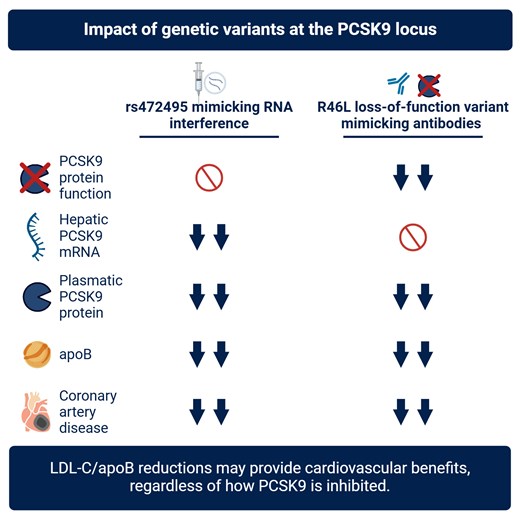-
Views
-
Cite
Cite
Eloi Gagnon, Dipender Gill, Jérôme Bourgault, Émilie Gobeil, Patricia L Mitchell, Arnaud Girard, Audrey Paulin, Christian Couture, Yohan Bossé, Sébastien Thériault, Patrick Mathieu, Marie-Claude Vohl, André Tchernof, Kausik K Ray, John J P Kastelein, Benoit J Arsenault, RNA interference versus antibody-based PCSK9 inhibition for the prevention of cardiovascular disease: A drug-target Mendelian randomization study, Cardiovascular Research, 2025;, cvaf078, https://doi.org/10.1093/cvr/cvaf078
Close - Share Icon Share
Abstract
RNA interference therapies targeting liver expression of the gene proprotein convertase subtilisin/kexin type 9 (PCSK9) lower low-density lipoprotein cholesterol (LDL-C) and apolipoprotein B (apoB) levels. As opposed to monoclonal antibodies, which neutralise PCSK9 circulating protein, their effect on atherosclerotic cardiovascular disease (ASCVD) outcomes is unknown. We used genetic variants in the PCSK9 locus influencing PCSK9 function or gene expression in the liver to determine whether antibodies against PCSK9 and RNA interference therapies could have comparable effects on ASCVD.
We performed genome-wide genotyping and RNA sequencing of 504 human liver sample and identified a genetic variant (rs472495) explaining 5.6% of liver PCSK9 gene expression to mimic lifelong RNA interference of PCSK9. We used the PCSK9 R46L variant, known to alter PCSK9 function, to model antibody-based PCSK9 inhibition. For each standard deviation decrease in apoB levels, both variants were similarly associated with coronary artery disease risk: (OR = 0.40 [95% CI: 0.31-0.51], p = 3.7e-13 for rs472495 which affects liver PCSK9 expression) and (OR = 0.48 [95% CI: 0.43-0.55], p = 1.3e-28 for R46L which affects protein levels). Comparable effects of these two genetic inhibition approaches were observed for aortic stenosis, heart failure, ischemic stroke, type 2 diabetes and glycemic traits as well as non-alcoholic fatty liver disease and liver enzymes.
For a given reduction in apoB levels, genetically predicted reductions in PCSK9 function (mimicking PCSK9 neutralizing antibodies) and liver PCSK9 gene expression levels (mimicking PCSK9 RNA interference) were comparably associated with a lower risk of coronary artery disease. These genetic data suggest that LDL-C/apoB reductions may provide cardiovascular benefits, regardless of how PCSK9 function is inhibited.





